The main goal for the IAEA (International Atomic Energy Agency) is to propagate atomic energy. This is stated clearly in paragraph 2 of the IAEA statute:
"The Agency shall seek to accelerate and enlarge the contribution of atomic energy to peace, health and prosperity throughout the world."Moreover, many UN agencies are subordinate to the IAEA. This particularly applies to the World Health Organization (WHO). On the strength of an agreement signed on 28 May 1959 (WHA 12-40), the IAEA can veto any research carried by WHO which would be in opposition to implementation of paragraph 2 of the IAEA statute. One statement in this agreement reads:
"It is recognized by the World Health Organization that the International Atomic Energy Agency has the primary responsibility for encouraging, assisting and coordinating research on, and development and practical application of, atomic energy for peaceful uses throughout the world without prejudice to the right of the World Health Organization to concern itself with promoting, developing, assisting, and coordinating international health work, including research, in all its aspects."So it's easy to assess the relative value of reports about the effects of nuclear disasters published by the pro-nuclear institutions, including the famous 2005 report on Chernobyl (a favorite reference for pro-atomic lobbyists). In short, in the interest of "encouraging, assisting and coordinating research on, and development and practical application of, atomic energy" such reports are very probably biased and tend to downplay the extent of the radiation danger to people.
It seems however that the European Commission is slowly distancing itself from the IAEA. The Commission created its own institution, the European Committee on Radiation Risk (ECRR), which overruled an idiotic model of allowable radiation doses prepared by other pro-atomic lobbyists associated with the International Commission on Radiological Protection (ICRP).
In addition, the ECRR published "Chernobyl 20 Years On: Health Effects of the Chernobyl Accident" edited by Prof Busby and Prof Yablokov that is clearly contradictory to the WHO/IAEA/ICRP/UNSCEAR findings from 2005. The professors found that Chernobyl caused the deaths, through fatal cancers, of up to 1.8 million people. And that was a "conservative estimate."
Read the first edition and weep.
'Worse' still (for atomic apologists), the New York Academy of Sciences (NYAS) published an update to that report in December 2009, entitled "Chernobyl: Consequences of the Catastrophe for People and the Environment".
Exemplary reviews with links to NYAS can be found here, here and here.
So, the information on so-called safe total doses given by "experts" are all lies spread throughout decades by pro-atomic military and civilian lobbies. The model of "allowable radiation doses", based on an absorbed dose (of external radiation), set by the ICRP on the basis of contamination tests and the effects upon the Hiroshima and Nagasaki populations, is pseudo-science because it's based on false data.
It's interesting to note how the Atomic Bomb Casualty Commision (ABCC) established by US government carried out the survey, at least, officially. The examined group consisted of those who survived the explosion. The control group consisted of those who arrived in nearby cities immediately after the explosion looking for family and friends and to work on reconstruction! Apparently these 'scientists' assumed that the contaminated region conveniently stopped being contaminated a few days after the bombs were dropped!
You can read more on this seriously flawed survey named "Life Span Study" (LSS) in the excerpt from A Primer in the Art of Deception. The Cult of Nuclearists, Uranium Weapons and Fraudulent Science by Paul Zimmerman.
So they were comparing radiated people with... other radiated people!. No wonder they found an insignificant difference in radiation levels between the study group and "control" group. It is also not surprising then that their conclusion was that effects from radiation are only minor and that Japan today is as safe as anywhere else in the world.
You'll find a thorough critique of the currently in vogue model of "allowable doses" in the CERRIE report.
The ECRR's recommendation concerning the Fukushima situation, in total contrast to anything said by the IAEA, can be read here.
There is further useful information here from a conference held by the ECRR in Riga in 2009. At the bottom are links to two presentations. Look at the one by Prof Busby. On page 28 there is an interesting picture showing changes in radiation for cesium 137 and cesium 134 during and after Chernobyl.
Notice that the highest values were around 300 Bq and recall that a few days ago Japanese authorities prohibited giving children tap water when contamination exceeded 100 Bq. They emphasized, however, that a safe dosage for other groups is 300 Bq. Coincidence? I doubt it. The official line is that the effects of Chernobyl were "insignificant" i.e. a level of 300 Bq is perfectly "safe"!
Certainly, the 'average Joe' should wonder why water contamination concerns only iodine 131, and not iodine 131 and cesium 137, because the latter is far more water-soluble!
Then we have this from Natural News:
Virtually all the numbers you're seeing about the radioactivity coming out of Fukushima are based on iodine-131 which only has a half-life of 8 days, not the far more dangerous cesium-137 which has a half-life of 30 years. So while the mainstream media reports that "radiation levels are falling rapidly" from the 7.5 million times reading taken a few days ago, what they're not telling you is that the cesium-137 radioactivity will take 30 years just to fall by 50 percent.And this from the Sofia News Agency:
It's the great global cover-up in all this: What happens to all the radioactive cesium being dumped into the ocean right now? It doesn't just burn itself out in a few months like iodine-131. This stuff sticks around for centuries.
A Russian nuclear expert has stated that the crisis situation in Fukushima is much worse than that in Chernobyl and might lead to a change in the scale for measuring nuclear emergencies. "The crisis in Japan will cost a lot more than Chernobyl in terms of economic and human losses," according to nuclear engineer Nataliya Mironova, who is a leading figure in Russia in the field. Mironova is visiting the USA together with other people engaged in anti-nuclear activism on the eve of the 25th anniversary of the Chernobyl tragedy of April 26, 1986. Meanwhile, it was revealed that radioactive water is leaking from a breach in the Fukushima NPP.Another interesting thing is that the official contamination data provided by TEPCO, the Japanese government and/or the IAEA is mainly concerned with gamma emitters. Coincidence? When it emerged at the end of March that plutonium 239 (an alpha emitter) was found in the soil on March 28, the The Financial Post immediately published an article about the allegedly healthy characteristics of this deadly substance. Just another coincidence? Why does that remind me of Ann Coulter telling us on Fox News that radiation exposure is good for us?
On March 30, I came across an attempt to cover up the Fukushima catastrophe in the US, where the Environmental Protection Agency (EPA) has decided to significantly lower (by many factors) its radiation safety standards for the American population by drastically raising the radiation contamination levels considered to be "safe".
The same terrible idea has also just been implemented in the EU, where a resolution passed on March 27 applies the very same measures for EU citizens. There the "allowable" level of food contamination with cesium 134 and 137 went up from 600Bq/kg to 12,500 Bq/kg!!!
The toxic relationship between the IAEA and WHO has been known for years. Two years ago The Guardian published this article.
Then we have this article from Sott.net:
Government Responds to Nuclear Accident by Trying to Raise Acceptable Radiation Levels and Pretending that Radiation is Good For UsThe European Commission actually reacted faster than the EPA.
"And now the EPA is considering drastically raising the amount of allowable radiation in food, water and the environment."
But there are some inaccuracies in the above article. Up until now, EU regulation 733/2008, in force since 15 July 2008, states in article 2 that allowable radiation for cesium 134 and 137 was 370 Bq/liter per kg of milk and dairy produce, and 600 Bq/kg per liter for other foodstuffs. See here (choose language and document format).
On March 25, the EU announced a significant increase of allowable limits for radioactive contamination of food and animal fodder. Regulation number 297/2011 came into force on March 27, 2011. EU regulation no. 297/2011 (choose language and document format). Here's a PDF in English.
Obviously you can't find any figures in regulation 297/2011. The EU prefers not to give its citizens "exhaustive" information on their regulations. Instead, they direct people to other regulations implemented after the Chernobyl disaster when disruption in food and fodder supplies to EU countries was feared.
One such document is regulation number 3954/1987 from 22 December 1987, which established upper allowable limits for food contamination at that time.
That was the first serious shift in allowable limits: cesium in dairy produce and other foodstuffs was capped at 370 and 600 Bq respectively in the 2008 regulation (733/2008). But looking back at regulation 3954/1987, we see that these figures were lowered from 1,000 and 1,250 Bq. So we might say that they were raised in the aftermath of Chernobyl to placate fears of political fallout, not least a public relations nightmare for the nuclear industry.
These latter figures are seen in the following table, taken from the 1987 regulation (3954/1987):
But that's not all! Another document the EU invokes in regulation number 297/2001 is regulation 944/89 from 12 April 1989 (choose language).
Only here (in article 2) do we find that the allowable limit of radioactive food and fodder contamination was increased tenfold relative to the older regulation (3985/1987), while at the same time the list of articles included in that regulation is much bigger. Presumably the numbers are being manipulated to accommodate the ever-increasing levels of radiation being detected in the years following a nuclear accident.
In summing up, the allowable contamination limit for cesium 134 or 137 increased as follows: for milk and dairy produce - from 370 Bq to 10,000 Bq/kg or liter; for other foodstuffs - from 600 Bq to 12,500 Bq/kg or liter!!!
As a side note, isn't it odd that 3 years after the 1986 disaster in Eastern Europe the limits were revised upwards? Doesn't it suggest how much we've been lied to about levels of radiation post-Chernobyl?
The FoodWatch Organization was first to notice that recent EU regulation 297/2011 made a mistake in comparing allowable limits between EU and Japan because it was based on European limits set back in 1987. To arrive at the current limits decided on this year, you have to multiply them by a factor of 10 (see paragraph 2 in regulation no 944/89).
What's interesting is that allowable contamination levels in Japanese regulations issued on March 17 2011 (i.e. enacted one week into the Fukushima catastrophe) are still lower than those in EU regulations from 1987 - those levels used in the comparison made by FoodWatch! They are also lower than recent EU regulations!
Source data for Japan
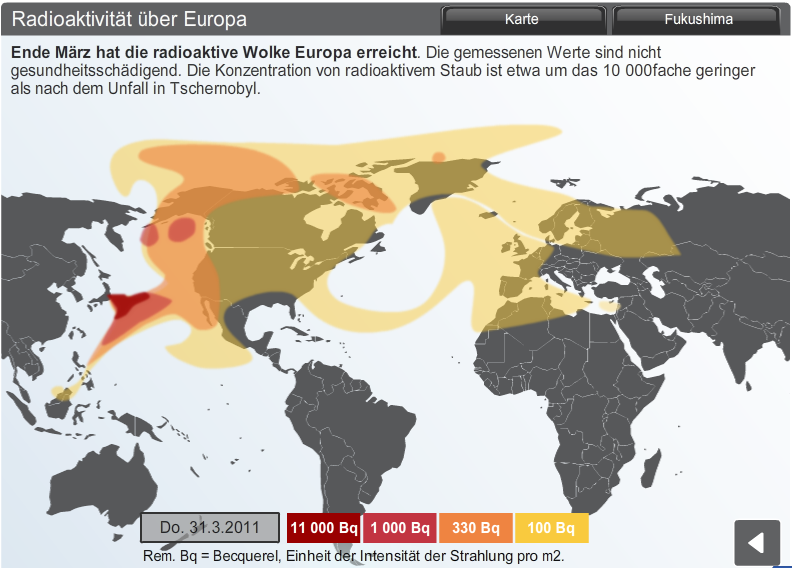
Does this betray how the EU, from behind closed doors, actually assesses the true scale of the Fukushima catastrophe? Is Fukushima the equivalent or worse than Chernobyl?
Why is regulation 297/2011 concerned only with imports from Japan? It rather looks like the trade concerns of a country which does not belong to the EU, along with European importers, are being put first when it comes to permitting contaminated food and fodder on the market! Isn't it an apparent violation of the rule of equal position of all business/economic entities through favouring the continued import of contaminated goods?
Why are European standards so incredibly low in comparison to Japanese standards? Allowable limits of radiation for food and fodder set by regulation 297/2011 are terribly high considering they deal with internal radiation (i.e. only after contaminated food and water is ingested!)
What's the point in setting limits so high, given that it has been proven that internal radiation (after ingestion) is many times more dangerous than external radiation? Why didn't they prohibit importing food from the areas most affected by radiation? Could this be yet another medical experiment conducted on an unaware EU population? Or worse still, could this be part of an opportunistic plan by the psychopaths in power to cull the human population...
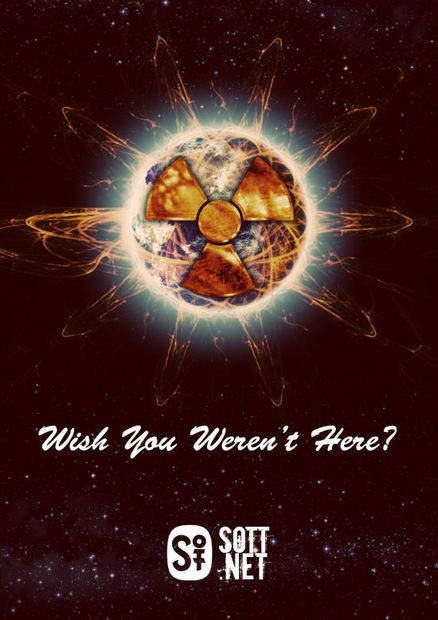
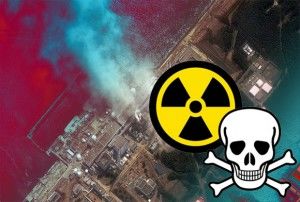
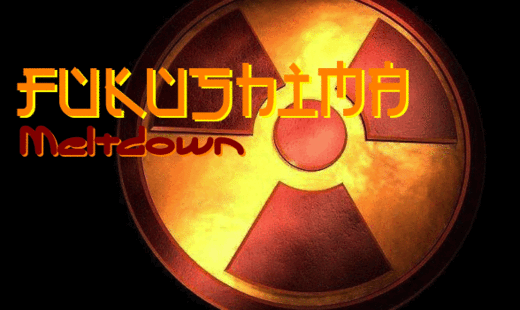
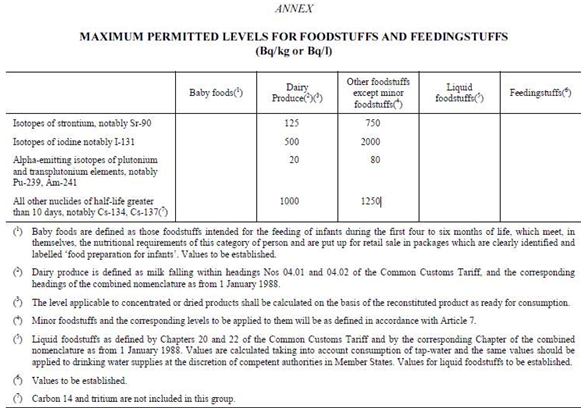



and important information for all. The World Health Organization agreement which makes them subordinate to the IAEA is very much a situation in which the fox is in charge of the henhouse. The tentacles of the nuclear power industry reach deep within governments and the military industrial complex. If there is anything good to come from Fukushima, it will be people waking up to how insane and insanely dangerous this technology really is.